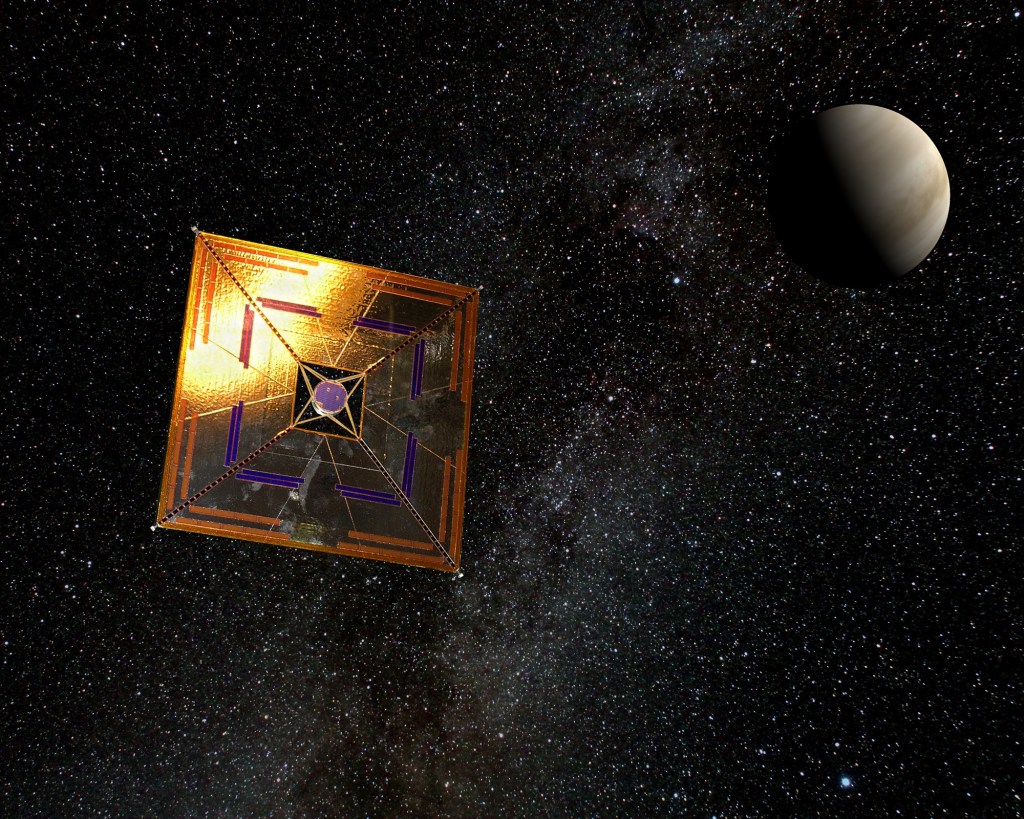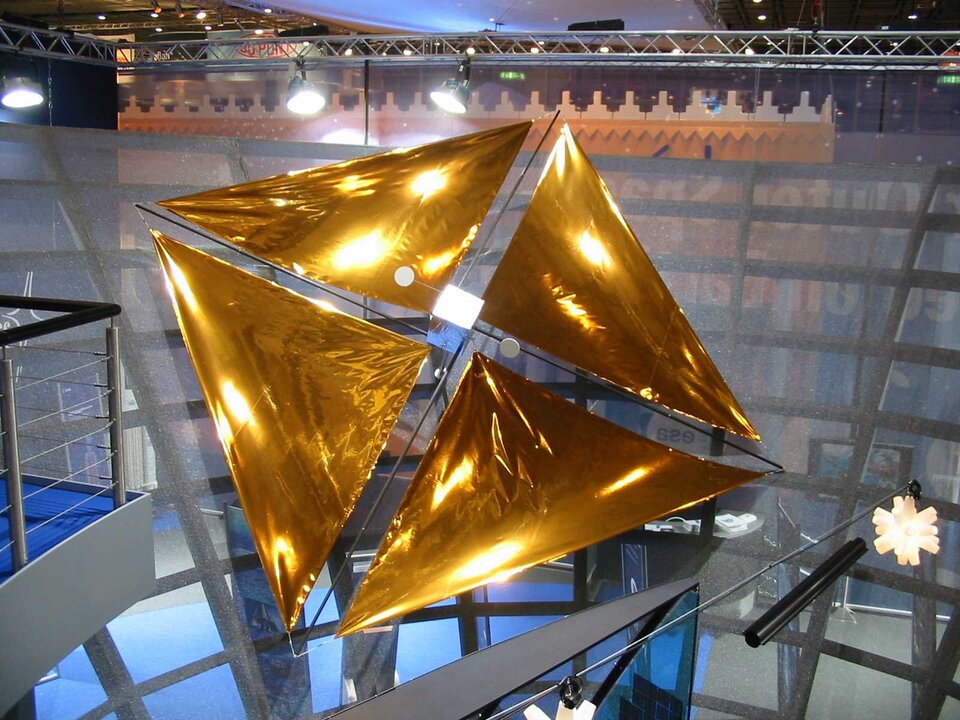NASA is growing new deployable designs and materials advancements for sun oriented sail impetus frameworks bound for future minimal expense profound space missions. Similarly as a boat is fueled by wind in a sail, sun based sails utilize the tension of daylight for drive, disposing of the requirement for ordinary rocket charge.
NASA's High level Composite Sun based Sail Framework, or ACS3, innovation showing utilizes composite materials - or a blend of materials with various properties - in its novel, lightweight blasts that send from a CubeSat. Information got from ACS3 will direct the plan of future bigger scope composite sunlight based sail frameworks that could be utilized for space weather conditions early admonition satellites, close Earth space rock surveillance missions, or interchanges transfers for manned investigation missions.
The essential target of the ACS3 innovation show is the fruitful arrangement of the composite blast sunlight based sail in low-Earth circle. In the wake of arriving at space, the ACS3 rocket will send its sun oriented power clusters and afterward start spreading out its sun based sail through four blasts that range the diagonals of the square and unspool to arrive at 23 feet (around 7 meters) long.
After roughly 25 minutes, the sun powered sail is completely conveyed, and the square-molded sun based sail estimates around 30 feet (around 9 meters) per side, or about the size of a little loft. A set-up of installed computerized cameras will get pictures of the sail during and after sending to evaluate its shape and arrangement.

ACS3's sails are upheld and associated with the rocket by blasts, what capability similar as a boat's blast that interfaces with its pole and keeps the sail rigid. The composite blasts are produced using a polymer material that is adaptable and supported with carbon fiber. This composite material can be moved for smaller stowage, yet stays solid and lightweight when unrolled.
It is additionally exceptionally solid and impervious to bowing and distorting because of changes in temperature. Sun oriented sails can work endlessly, restricted simply by the toughness of the sun based sail materials and rocket electronic frameworks in the space climate. The ACS3 innovation exhibit will likewise test an inventive tape-spool blast extraction framework intended to limit sticking of the snaked blasts during organization.
What is ACS3?
NASA's High level Composite Sunlight based Sail Framework, or ACS3, is a sun powered sail mission that will try out new sail blast materials in Earth circle. Planned to send off in the principal half of 2024 on Rocket Lab's Electron send off vehicle, ACS3 will convey a sail about the size of a little condo from a toaster size space apparatus.

Sun oriented sails bridle the force of daylight for shuttle drive. Space missions like The Planetary Society's LightSail 2 shuttle have shown the way that little space apparatus can utilize sun powered sails to change their circles, extending their potential purposes. Future sun oriented sail missions will require greater sails and lighter materials to expand their exhibition. ACS3 will utilize lightweight carbon fiber sail blasts rather than conventional metal blasts. This will be the principal trial of this innovation in space, and achievement will prepare for future missions to utilize significantly bigger sails.
What is Solar Sailing?

Light is comprised of particles called photons. Photons don't have mass, yet they have energy. As daylight bounces off a glossy sun oriented sail, a portion of its force gets moved, giving the sail a little push. This push is slight yet nonstop, and after some time can bestow more push to a space apparatus than customary substance rockets. Sun powered sails can arrive at special objections that are troublesome or difficult to access with other drive frameworks. They may likewise be our most ideal choice for interstellar travel.
How Will ACS3 Advance Solar Sailing?
The speed increase a sun oriented sail rocket gets from daylight relies upon the size of the sail and the mass of the shuttle. To increment execution, mission creators should look towards greater sails and lighter space apparatus.

Sun powered sails require long blasts to hold them tight. LightSail 2 and other sun oriented sail space apparatus utilize metal blasts, which are weighty and can twist eccentrically due to the warm and-cold temperature swings they experience in space. ACS3 will utilize composite blasts made of carbon fiber supported polymer. CFRP materials have high strength and low weight, and can be tracked down in various aviation, car, and clinical applications.
Each ACS3 sail blast estimates 7 meters (23 feet) in length, yet weighs only 900 grams, or 2 pounds, making them 75% lighter than metallic blasts. NASA says they are multiple times less vulnerable to twisting under outrageous temperature swings.
The CFRP blasts are sufficiently able to hold the sail tight, yet adaptable enough to wrap flawlessly around a focal shaft for send off. NASA is additionally researching the utilization of CFRP materials to construct human natural surroundings on the Moon or Mars. On the off chance that ACS3 is fruitful, NASA says composite sail blasts could be utilized for follow-on missions with sails as extensive as 2,000 square meters (21,500 square feet).
How ACS3 Works?
At its center, ACS3 is a CubeSat a little satellite worked to normalized aspects. LightSail 1 and 2 were 3-unit CubeSats about the size of a portion of bread. ACS3 is a 12-unit CubeSat multiple times bigger than LightSail.

The composite sail blasts send from measuring tape like focal shafts, very much like LightSail. The blasts take out four three-sided sails to frame a kite shape when completely conveyed, estimating 9 meters (30 feet) per side. With a pattern for the middle center, the all out sail region is around 80 square meters (860 square feet).
ACS3 will send off into Earth circle through Rocket Lab's Electron send off vehicle. When ACS3 effectively sends its sun based sail, the space apparatus will endeavor a progression of orbital changes to exhibit its capacities.
Interest in sun oriented cruising as an option in contrast to synthetic and electric impetus frameworks keeps on expanding. Utilizing daylight to drive little shuttle in lieu of consumable fuels will be worthwhile for the vast majority mission profiles and offers adaptability in rocket plan to assist NASA with meeting its missions' targets most proficiently.
Objectives: Show effective organization of the composite blast as well as sail pressing and sending frameworks in low-Earth circle.
Assess the adequacy of the shape and plan of the sun powered sail || Portray the push usefulness of the sail as the shuttle slowly changes circle || Gather information on the sail's exhibition to illuminate the plan regarding bigger, more perplexing frameworks.
Fast Facts:
This is the primary utilization of composite blasts as well as sail pressing and organization frameworks for a sunlight based sail in space. || ACS3's composite blasts are 75% lighter and intended to encounter multiple times less in-space warm bending change of shape under heat - than recently flown metallic deployable blasts. The sun based sail is intended to fit inside a 12-unit (12U) CubeSat, which estimates roughly 9 inches x 9 inches x 13 inches (23 centimeters x 23 centimeters x 34 centimeters), or about the size of a little microwave.
The composite blast innovation utilized for this ACS3 innovation exhibition could be utilized in later missions for sun oriented sails up to 500 square meters (5,400 square feet), about the size of a ball court. Follow-on composite blast advances now being developed will empower sun powered sails as extensive as 2,000 square meters (21,500 square feet).
Launch is Anticipated for The First Half of 2024.
Partners:
NASA's Langley Exploration Center in Hampton, Virginia, planned and constructed the ACS3 deployable composite blasts and sun oriented sail framework. || AST&Defense LLC of School Park, Maryland, planned and constructed the 12U CubeSat shuttle transport for the ACS3 innovation show.
NASA's Ames Exploration Center in California's Silicon Valley deals with the ACS3 project and planned and fabricated the ACS3 on-board camera analytic framework. || St Nick Clara College's Advanced mechanics Frameworks Lab in St Nick Clara, California, is giving CubeSat tasks backing to the ACS3 innovation exhibit.
NASA's Little Rocket Innovation program inside the office's Space Innovation Mission Directorate is supporting the ACS3 project and is giving the subsidizing to the send off. || NASA's Down Changing Improvement program inside the organization's Space Innovation Mission Directorate fostered ACS3's deployable composite blast innovation.
Frequently Asked Questions!
What is the best material for solar sails?
Current sun based sails are made of lightweight materials like Mylar or polyimide covered with a metallic intelligent covering. LightSail 2 purposes 4 three-sided Mylar cruises that are simply 4.5 microns (1/5000th of an inch) thick. They unfurl utilizing 4 cobalt amalgam blasts that loosen up like measuring tapes.
How fast can solar sails go?
Sunlight based sails have a greatest speed which is 10% the speed of light, which compares to 18,600 miles each second or, 67,100,000 mph. Sunlight based controlled shuttles can travel quicker than traditional rocket powered space apparatus because of steady light tension being applied to the sail pushing it forward.
What is the most efficient sail design?
Bermuda rig is by a long shot the most well known rig type, and it's the one utilized by all elite presentation yachts today since it conveys the best exhibition for upwind cruising contrasted with other apparatus types.
Could solar sails reach Mars in 26 days?
As per a paper as of late submitted to the diary Acta Astronautica, definite programmatic experiences show little, unbelievably lightweight sunlight based sails made with aerographite could head out to Mars in only 26 days — contrast that with traditional rocketry time evaluations of between 7-to-9 months.

